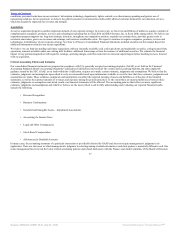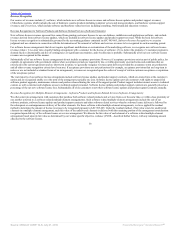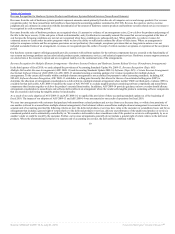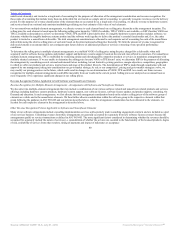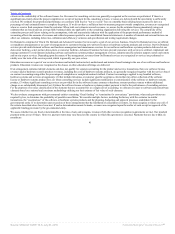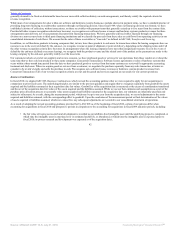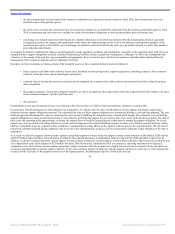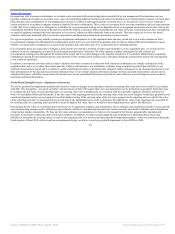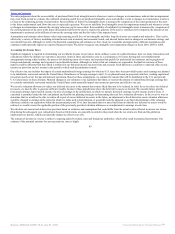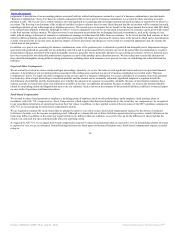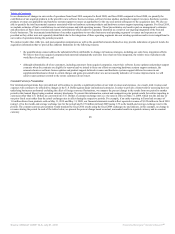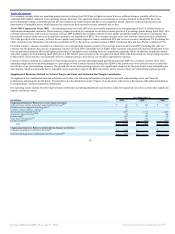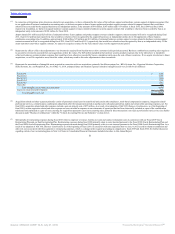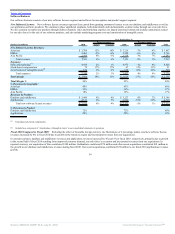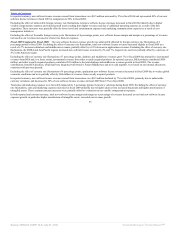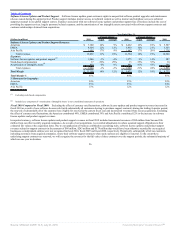Oracle 2009 Annual Report Download - page 51
Download and view the complete annual report
Please find page 51 of the 2009 Oracle annual report below. You can navigate through the pages in the report by either clicking on the pages listed below, or by using the keyword search tool below to find specific information within the annual report.
Table of Contents
estimated forfeiture rate is updated for actual forfeitures quarterly. We also consider on a quarterly basis whether there have been any significant changes in facts
and circumstances that would affect our expected forfeiture rate.
We estimate the fair values of employee stock options using a Black-Scholes-Merton valuation model. The fair value of an award is affected by our stock price
on the date of grant as well as other assumptions including the estimated volatility of our stock price over the term of the awards and the estimated period of time
that we expect employees to hold their stock options. The risk-free interest rate assumption we use is based upon United States treasury interest rates appropriate
for the expected life of the awards. We use the implied volatility of our publicly traded, longest-term options in order to estimate future stock price trends as we
believe that implied volatility is more representative of future stock price trends than historical volatility. In order to determine the estimated period of time that
we expect employees to hold their stock options, we have used historical rates of employee groups by seniority of job classification. Our expected dividend rate
is based upon an annualized dividend yield based on the per share dividend declared by our Board of Directors. The aforementioned inputs entered into the
option valuation model we use to fair value our stock awards are subjective estimates and changes to these estimates will cause the fair values of our stock
awards and related stock-based compensation expense that we record to vary.
We record deferred tax assets for stock-based awards that result in deductions on our income tax returns, based on the amount of stock-based compensation
recognized and the fair values attributable to the vested portion of stock awards assumed in connection with a business combination, at the statutory tax rate in
the jurisdiction in which we will receive a tax deduction. Because the deferred tax assets we record are based upon the stock-based compensation expenses in a
particular jurisdiction, the aforementioned inputs that affect the fair values of our stock awards may also indirectly affect our income tax expense. In addition,
differences between the deferred tax assets recognized for financial reporting purposes and the actual tax deduction reported on our income tax returns are
recorded in additional paid-in capital. If the tax deduction is less than the deferred tax asset, the calculated shortfall reduces our pool of excess tax benefits. If the
pool of excess tax benefits is reduced to zero, then subsequent shortfalls would increase our income tax expense. Our pool of excess tax benefits is computed in
accordance with the alternative transition method pursuant to ASC 718.
To the extent we change the terms of our employee stock-based compensation programs, experience market volatility in the pricing of our common stock that
increases the implied volatility calculation of our publicly traded, longest-term options, refine different assumptions in future periods such as forfeiture rates that
differ from our current estimates, or assume stock awards from acquired companies that are different in nature than our stock award arrangements, amongst other
potential impacts, the stock-based compensation expense that we record in future periods and the tax benefits that we realize may differ significantly from what
we have recorded in previous reporting periods.
Allowances for Doubtful Accounts
We make judgments as to our ability to collect outstanding receivables and provide allowances for the portion of receivables when collection becomes doubtful.
Provisions are made based upon a specific review of all significant outstanding invoices. For those invoices not specifically reviewed, provisions are provided at
differing rates, based upon the age of the receivable, the collection history associated with the geographic region that the receivable was recorded and current
economic trends. If the historical data we use to calculate the allowances for doubtful accounts does not reflect the future ability to collect outstanding
receivables, additional provisions for doubtful accounts may be needed and our future results of operations could be materially affected.
Results of Operations
Impact of Acquisitions
The comparability of our operating results in fiscal 2010 compared to fiscal 2009 is impacted by our acquisitions, primarily the acquisition of Sun in our third
quarter of fiscal 2010.
The comparability of our operating results in fiscal 2009 compared to fiscal 2008 is impacted by our acquisitions, primarily the acquisition of BEA Systems, Inc.
in our fourth quarter of fiscal 2008.
47
Source: ORACLE CORP, 10-K, July 01, 2010 Powered by Morningstar® Document Research℠


